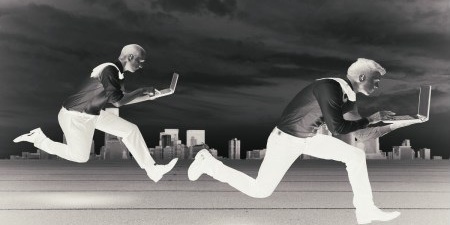“The Desk-athlon”…getting you and your back on track
Posted on 9th April 2018 at 13:29
With it being decathlon day at the Commonwealth Games 2018 on the Gold Coast in Australia there seemed no better day than today to share with you my top tips for managing your back in the workplace. I present to you the “Desk-athlon” a ten step guide to achieving “gold-standard” health for your spine. Do you want to give that stiff achy back the “high jump?” Then I suggest being “quick out of the blocks” and get working on this plan to help start overcoming the “hurdles” a sore back can bring. I promise no more cheesy one-liners just good quality information.
We know that sitting at a desk for a number of hours a day can have several unwanted effects including reduced cardiovascular efficiency, fatigue, poor concentration levels and also a increased stress on our spines and other joints. This has been well documented in the media. According to CNN news the most far reaching impact is death! Please don’t let this cause too much anxiety though as we all know the impact that fake news is having across the pond. If you want a more balanced UK based media opinion check out the blog written by the Huffington Post … the information is a bit less severe! From a more scientific perspective there are a number of interesting research papers that have outlined the impact that prolonged sitting can have on spinal health (Hallman et al 2016, Gupta et al 2015, Billy et al 2014, Lis et al 2007).
The Desk-Athlon
1. A good sitting posture
This is where everything begins. The cornerstone to this series of exercises. A lot of people ask what a good posture is? The answer quite simply is one that is regularly corrected! The spine does not like being static for long periods of time so regularly changing the position of the spine is very important. Begin the correction from the pelvis by gently rolling up onto the sitting bones (which can be felt underneath your bottom). From there, gently lengthen through the breastbone and open the chest. Draw the head in gently to balance on top of the spine (not forward of it!). The shoulders should be relaxed. Hold this position for a few seconds and repeat regularly during the day.

2. Cervical Retractions
This exercise will help to correct the position of the head and neck on the shoulders, as often with prolonged computer use the head tends to poke forwards. Please keep your eyes facing forwards and slide the head backwards. Hold for a few seconds then relax. You can assist with your thumb and first finger guiding from the chin.
3. Cervical Rotations
They help to ensure that the joints and soft tissues of the neck keep mobile. Start with the good postural alignment and keep your shoulders relaxed. Slowly turn your head to look over the right shoulder, then return to the start position and slowly turn to the left. Hold for a few seconds then relax.
4. Cervical Side- Bends
Here are 2 variations of a stretch that will help to keep the muscles either side of the neck mobile. Firstly, slowly take one ear down to the shoulder without lifting the opposite shoulder. Hold for a few seconds then relax and repeat to the other side.
Then, once completing a few repetitions to each side of the above exercise, try the variation below. The difference being that when you take your ear to the shoulder you look down to the floor at the end of the movement. Repeat each exercise for both sides.
5. Scapula Retractions
With the head tending to drift forwards in sitting, it’s only natural that the shoulders follow suit. This can make the muscles that support the shoulder blade a little weaker. With this in mind slowly pull the shoulder blades down and inwards towards each other. Slowly repeat a few times and hold each one for a few seconds.
6. Pectoral Stretch
This is to also help with the above exercise. However, this time you will stretch the tight muscles at the front of your shoulder. It is also another good excuse for getting up from your chair. Please repeat the stretch as the video demonstrates.
7. Thoracic Rotation
The upper and middle part of the back is particularly prone to becoming stiff. You know that hard to reach area in between the shoulder blades. It can give rise to all sorts of unusual symptoms including fuzziness in your hands, pain radiating to both shoulders and chest as well as pain in between your shoulder blades. In a Cossack position slowly rotate your back to one side and repeat to the other side. As the video shows you can do this on a swiss ball if you have one but the office chair will more than suffice.
Or why not get up from the chair and perform it in standing. Just remember to keep those hips fixed so you focus the movement from the upper/mid back.
8. Thoracic Extension
Without arching your neck too far backwards slowly extend your upper back in the chair.
As an alternative when you get home from work (and it’s not very often we advocate just lying down) try a very simple yet effective exercise. Fold a large towel in half length ways and then roll it up into a cylinder (or as the video demonstrates if you have a foam roller use this). Lie down on the floor with both knees bent and the feet resting on the floor. Place the rolled up towel between your shoulder blades. Rest in this position for up to 10 minutes. Focus on relaxed breathing in this position too. Trust me it’s great for helping to loosen that upper back area!
9. Thoracic Side – Bends
There’s still just a bit more work to do on that upper back region. Remember if you can keep this part of your back more mobile it will help to reduce the demands placed on the neck and lower back muscles when sitting for prolonged periods of time. Slowly bend from side to side in sitting. You can also do this exercise with your hands behind your head.
10. Hip Flexor Stretches
Finally, get out of that chair and make use of your desk in another way. Sitting for long periods of time means that the muscles at the front of the hip (Rectus Femoris and Psoas) are in a shorter position. We know that this can put extra strain on your lower back as they attach onto the front of the pelvis. Repeat this simple stretch as outlined by the video on alternate legs.
Congratulations you have completed the “Desk-athlon”. Remember, that this series of simple mobilisation exercises and stretches should be carried out a couple of times during the working day. You may want to break the programme up and focus on 5 exercises at a time. Try and fit it into your schedule to suit you. Even if you do these exercises once a day you will get benefit. I would suggest performing each exercise a few times. Also one other thing to remember is that stretching and improving mobility is only one part of the equation that helps your spine function more effectively. These exercises should be coupled with something like Pilates or an exercise based programme that helps to maintain muscle strength and control whilst also encompassing cardiovascular fitness . Finally don’t forget the first point that was made – a good posture. A regular change of position needs to be incorporated in to your working day. We know that the spine likes to be moved regularly, so don’t take your back side for granted and give it, as well as the rest of your body, the exercise it deserves by getting up out of your seat!
These exercises are a guide for helping to improve spinal mobility and flexibility. If you are experiencing any pain in the back or other joints/muscles of the body an assessment from a chartered physiotherapist would be recommended before commencing these.
Share this post:




